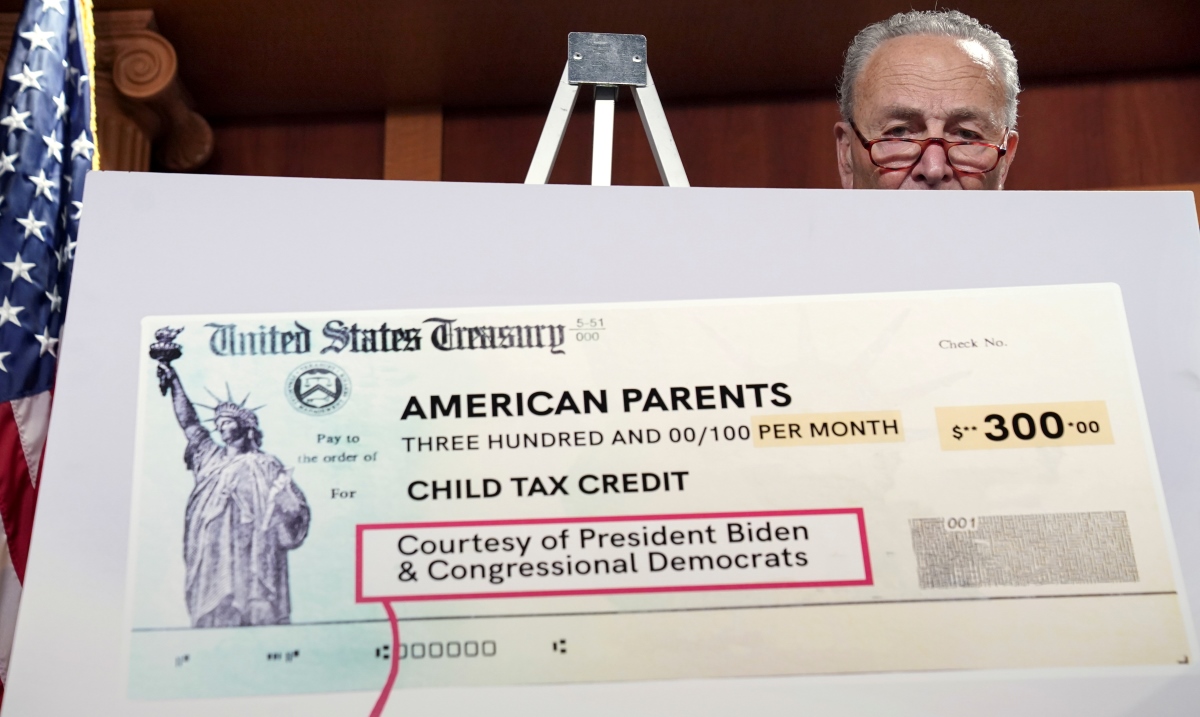

Finance
Why Get Life Insurance For A Child?
Published: October 16, 2023
Explore the benefits of getting life insurance for your child and secure their financial future. Find out how this smart financial move can provide peace of mind and long-term financial stability.
(Many of the links in this article redirect to a specific reviewed product. Your purchase of these products through affiliate links helps to generate commission for LiveWell, at no extra cost. Learn more)
Table of Contents
- Introduction
- What is life insurance for a child?
- Benefits of having life insurance for a child
- Protection and Financial Security
- Future Insurability and Locked-In Rates
- Cash Value and Potential Savings
- Education and Career Opportunities
- Coverage Options and Considerations
- How to Choose the Right Life Insurance Policy for a Child
- Understanding the Cost and Premium Factors
- Common Misconceptions Debunked
- Conclusion
Introduction
Life insurance is a financial product that provides protection and peace of mind by ensuring that loved ones are taken care of financially in the event of unexpected circumstances. While it is common for adults to purchase life insurance to protect their families, many people overlook the option of obtaining life insurance for their children.
Life insurance for a child may seem unnecessary or even morbid, but there are several compelling reasons to consider it. In this article, we will explore the benefits of having life insurance for a child and why it can be a wise investment for their future.
It is important to note that life insurance for a child should not be viewed as an investment tool or a means of profiting from their lives. Instead, it is a way to protect their financial well-being and provide for their future needs.
Now, let’s take a closer look at the advantages of having life insurance for a child.
What is life insurance for a child?
Life insurance for a child is a type of insurance policy that provides coverage for a child’s life. It is designed to protect the child’s financial future and provide a safety net for their loved ones. The policy is typically taken out by the child’s parent or guardian, who acts as the policy owner and pays the premiums.
The coverage amount for a child’s life insurance policy is usually modest, as the main purpose is to cover funeral expenses in the unfortunate event of the child’s death. However, there are some policies that offer additional benefits, such as cash value accumulation, that can be utilized in the future.
Life insurance for a child can be purchased as a standalone policy or as a rider on the parent’s existing life insurance policy. It is important to note that the child is the insured party, while the parent or guardian is the policy owner. The policy is typically in effect until the child reaches a certain age, often between 18 and 25 years old, at which point they may have the option to convert the policy into a permanent life insurance policy.
It is worth mentioning that life insurance for a child is different from life insurance for adults, as it primarily focuses on providing financial protection rather than income replacement. The purpose of this type of insurance is to alleviate the financial burden that may arise from unexpected events and ensure that the child’s future remains secure.
Now that we have a basic understanding of what life insurance for a child entails, let us delve into the benefits it offers.
Benefits of having life insurance for a child
While the thought of getting life insurance for a child may initially seem unnecessary, there are several significant benefits to consider. Let’s explore some of the key advantages:
1. Protection and financial security: Life insurance for a child provides a safety net for their loved ones in the event of an untimely death. It can help cover funeral expenses, medical bills, and any other outstanding debts, easing the financial burden during a difficult time.
2. Future insurability and locked-in rates: Having life insurance for a child guarantees their future insurability regardless of any changes in their health or occupation. It also provides an opportunity to lock in lower rates, ensuring affordable coverage as they grow older.
3. Cash value and potential savings: Some life insurance policies for children accumulate cash value over time. This cash value can be accessed in the future for various purposes, such as paying for education expenses, starting a business, or as a source of emergency funds.
4. Education and career opportunities: With a life insurance policy in place, parents can invest in their child’s educational future. The policy’s cash value can be used to fund college tuition, vocational training, or other educational expenses, providing financial support and opening doors to a successful career.
5. Financial legacy and inheritance: Life insurance for a child can serve as a form of inheritance, allowing them to have financial stability and security from an early age. This can provide opportunities for long-term financial growth and create a lasting legacy for future generations.
6. Building a strong financial foundation: By introducing the concept of life insurance early on, children can develop a sense of financial responsibility and learn the importance of protecting their future. It instills valuable lessons about the value of financial planning, saving, and investing.
7. Supplementing existing coverage: Life insurance for a child can complement the coverage provided by their parents’ policies. It ensures that there is additional financial support available in case the parent’s policy does not adequately cover all expenses related to the child’s well-being.
Overall, life insurance for a child offers a range of benefits that extend beyond immediate financial protection. It provides peace of mind and the reassurance that their future will be secure. By investing in a life insurance policy for a child, parents can protect their loved ones and lay a strong foundation for their financial well-being.
Protection and Financial Security
One of the primary benefits of having life insurance for a child is the protection and financial security it provides. While no parent wants to think about the unimaginable loss of a child, having life insurance in place ensures that they are financially supported during a difficult time.
In the unfortunate event of a child’s death, life insurance can help alleviate the financial burden that may arise. Funeral expenses, medical bills, and any outstanding debts can be covered by the proceeds of the policy. This provides the family with the necessary financial support to mourn the loss and begin the healing process without the added stress of financial strain.
Furthermore, life insurance for a child also extends its benefits to the child’s siblings and parents. Losing a child can have a profound impact on the family’s emotional well-being, and having financial assistance can help ease the transition during such a challenging time. It can provide stability and support, allowing the family to focus on healing and rebuilding their lives.
Additionally, life insurance for a child can offer financial security in cases where the child develops a serious illness or medical condition. Some policies offer riders that provide additional coverage in the event of a terminal illness or critical illness diagnosis. This can help cover medical expenses and provide financial support for any specialized treatment or care that may be required.
It’s important to note that life insurance for a child is not meant to replace the emotional loss experienced in the event of their death. Rather, it serves as a means to provide financial stability and security during a time of grief. It allows families to focus on healing and recovery without the added stress of financial worries.
Overall, life insurance for a child offers valuable protection and financial security. It ensures that in the event of an untimely death or a serious illness, the family is provided with financial support to navigate through a challenging period. While it may be a difficult decision for some parents to consider, having life insurance for a child can offer peace of mind and the assurance that their loved ones will be taken care of.
Future Insurability and Locked-In Rates
One of the unique benefits of having life insurance for a child is the guarantee of future insurability and the opportunity to lock in favorable rates. By obtaining life insurance at a young age, parents can secure their child’s ability to obtain coverage in the future, regardless of any changes in their health or occupation.
As we know, health conditions can arise unexpectedly, and insurance companies may impose exclusions or charge higher premiums for individuals with pre-existing conditions. However, when a child is insured early in life, their coverage is not impacted by any future health conditions they may develop.
Furthermore, life insurance policies for children often offer the option to convert the policy to a permanent life insurance policy once the child reaches a certain age, typically between 18 and 25 years old. This conversion feature allows the child to continue their coverage into adulthood, without the need to undergo a new application process or undergo medical underwriting. They can maintain the same level of coverage and benefits at a predetermined rate, providing them with a valuable and affordable life insurance solution as they grow older.
By locking in rates at a young age, parents can take advantage of the lower premiums associated with children’s life insurance policies. Premiums are typically based on the child’s age and health at the time of coverage initiation. As the child ages, their premiums may increase significantly, especially if they develop health issues or engage in risky activities. However, the premiums for a child’s life insurance policy remain level throughout the duration of the coverage, ensuring affordability for the future.
Additionally, the ability to maintain a policy with locked-in rates can be particularly beneficial if the child develops a medical condition later in life that may make it difficult for them to obtain affordable coverage. They can continue their existing policy without facing increased premiums or policy exclusions due to their health condition.
Ultimately, life insurance for a child not only provides immediate protection and financial security, but it also secures their future insurability and locks in favorable rates. By getting coverage early in life, parents can guarantee access to life insurance for their child in the future, regardless of any health changes, and take advantage of lower premiums that will remain constant as the child grows older.
Cash Value and Potential Savings
Life insurance for a child not only offers protection and financial security but can also provide potential savings and cash value accumulation over time. Some life insurance policies for children have a savings component that allows for the accumulation of cash value, providing additional financial flexibility and potential savings opportunities.
With a cash value component, a portion of the premiums paid for the child’s life insurance policy goes towards building up a cash value over time. This cash value grows on a tax-deferred basis, meaning that it is not subject to immediate taxation like other investments or savings accounts. This allows the cash value to potentially accumulate and grow at a faster rate.
Parents can leverage the cash value accumulated within the policy for various purposes in the future. For example, it can be used to help pay for the child’s education expenses, such as college tuition, books, or housing costs. By tapping into the cash value of the policy, parents can provide financial support and opportunities for their child’s academic pursuits without the need to take on additional loans or rely solely on their income.
In addition to education expenses, the cash value can also be used for other financial needs that may arise, such as starting a business, purchasing a home, or providing a financial safety net during times of emergency or unexpected expenses. It offers the flexibility to access funds when they are needed most, without the need to liquidate other assets or incur debt.
It’s important to note that accessing the cash value of a life insurance policy for a child may impact the death benefit. Withdrawing funds from the policy will reduce the account balance and subsequently reduce the death benefit amount that would be paid out in the event of the child’s death.
However, if the cash value is not utilized during the child’s lifetime, it can continue to grow and serve as a potential inheritance for future generations. In this way, life insurance for a child can help create a lasting financial legacy.
Overall, life insurance for a child provides a unique opportunity to accumulate cash value over time. This cash value can be utilized for various purposes, such as education expenses or serving as a potential savings option for the child’s future. It offers financial flexibility and the potential for long-term savings, providing an added layer of financial security and opportunities for the child’s future.
Education and Career Opportunities
Life insurance for a child not only provides financial protection but can also open up doors for education and career opportunities. By having a life insurance policy in place, parents can invest in their child’s future and set them up for success.
One of the key benefits of having life insurance for a child is the ability to use the policy’s cash value to fund their education expenses. The cash value that accumulates within the policy can be accessed to pay for college tuition, vocational training, or other educational costs. This financial support can alleviate the burden of student loans and provide the child with the opportunity to pursue their academic goals without the added stress of financial constraints.
Moreover, having life insurance for a child can help create a solid foundation for their career. With the financial security provided by the policy, parents can support the child’s career endeavors, whether it involves starting a business, pursuing further professional training, or exploring different vocational paths. The cash value component of the policy can be used as a source of funding for these career-related ambitions, enabling the child to invest in their future and pursue their passions.
Additionally, life insurance for a child can play a crucial role in providing financial stability during the transitional periods of education and early career development. As the child completes their education and enters the workforce, they may experience fluctuations in income or face unexpected financial challenges. The cash value within the policy can serve as a safety net during these times, providing a source of funds that can be accessed if needed.
By instilling the importance of financial planning and responsibility early on, life insurance for a child can also help develop valuable financial skills. The ownership and understanding of a life insurance policy provide an opportunity for parents to educate their child about financial matters, teaching them about the concept of insurance, savings, and the long-term benefits of financial planning.
Overall, life insurance for a child can significantly impact their education and career opportunities. It offers financial support for education expenses, provides a safety net during transitional periods, and helps instill important financial skills. By investing in a life insurance policy for their child, parents can contribute to their future success and provide them with the foundation to thrive in their educational and professional endeavors.
Coverage Options and Considerations
When considering life insurance for a child, it is essential to understand the available coverage options and consider various factors to make an informed decision. Here are some key aspects to consider:
Type of policy: There are typically two types of life insurance policies for children: term life insurance and permanent life insurance. Term life insurance provides coverage for a specified period, while permanent life insurance offers lifelong coverage. Each type has its own advantages and considerations, so it’s important to evaluate your specific needs and financial goals.
Insurance needs: The coverage amount required for a child’s life insurance policy is generally lower compared to an adult’s policy. It is crucial to determine the appropriate coverage amount based on factors such as funeral expenses, outstanding debts, and potential financial needs in the future.
Medical underwriting: Most life insurance policies for children do not require a medical exam or extensive underwriting. However, some policies may have basic health questions or medical history considerations. It’s important to disclose any relevant medical information to ensure accurate coverage and to avoid any future disputes regarding policy claims.
Riders and additional benefits: Some life insurance policies for children offer riders or additional benefits that can enhance the coverage. These may include options such as critical illness riders, which provide coverage in case the child is diagnosed with a serious medical condition. Consider whether these additional features are necessary for your specific situation and if they align with your long-term goals.
Premiums and payment flexibility: Premiums for a child’s life insurance policy are typically lower compared to those for adult policies. It’s important to evaluate your budget and determine the affordability of premiums. Additionally, consider whether the policy offers flexible payment options, such as annual, semi-annual, or monthly payments.
Policy ownership and beneficiaries: Parents or legal guardians usually own the life insurance policy on a child’s life. It’s important to designate primary and contingent beneficiaries who would receive the death benefit in the event of the child’s passing. Considering the changing dynamics of relationships, it may be necessary to review and update the beneficiaries as circumstances evolve.
Policy termination: Life insurance policies for children typically terminate at a specified age, often between 18 and 25 years old. At that point, the child may have the option to convert the policy into a permanent life insurance policy or purchase additional coverage. It’s important to understand the policy terms and evaluate the available options when the policy is set to terminate.
Taking the time to thoroughly understand the coverage options and considerations is crucial when selecting a life insurance policy for a child. Discussing your options with a knowledgeable insurance professional can provide valuable guidance and ensure that you make the most informed decision for your child’s financial protection.
How to Choose the Right Life Insurance Policy for a Child
Choosing the right life insurance policy for a child involves careful consideration of various factors to ensure that you make an informed decision. Here are some steps to help you choose the right policy:
Evaluate your needs: Consider your specific needs and goals for purchasing life insurance for your child. Determine the coverage amount required to provide financial protection, such as funeral expenses and outstanding debts, as well as any additional benefits you may want to include.
Research and compare policies: Take the time to research and compare different policies from reputable insurance providers. Look for policies that offer the coverage options and benefits that align with your needs and priorities. Consider the type of policy (term or permanent), premium costs, cash value growth potential, and any riders or additional features available.
Understand the terms and conditions: Read and understand the terms and conditions of the policy, including the coverage duration, premium payment options, policy termination age, conversion opportunities, and any exclusions or limitations. Ensure that the policy aligns with your long-term goals and addresses your specific concerns.
Review the financial strength of the insurer: Choose an insurance company with a strong financial track record and solid reputation. Research the company’s financial strength ratings and customer reviews to ensure that they will be able to fulfill their obligations in the future.
Seek professional guidance: Consult with an experienced insurance professional who specializes in life insurance. They can provide personalized advice, explain complex policy details, and help you navigate through your options. A knowledgeable professional can guide you in determining the appropriate coverage and selecting the most suitable policy for your child.
Consider long-term needs: Look beyond the immediate requirements and consider the long-term needs of your child. Think about their potential future goals, such as higher education or starting a business. Consider a policy that offers potential cash value growth or conversion options, which can provide financial flexibility and adaptability as your child grows older.
Review and update periodically: Regularly review your child’s life insurance policy to ensure that it still meets your evolving needs. As your child’s circumstances change, such as reaching adulthood or starting a family, you may need to consider adjustments to the coverage amount or beneficiaries. Stay proactive and make updates as necessary.
Remember, choosing the right life insurance policy for your child is a decision that requires careful consideration. By evaluating your needs, researching your options, seeking professional advice, and considering the long-term implications, you can make an informed choice that provides the necessary financial protection and peace of mind for your child’s future.
Understanding the Cost and Premium Factors
When considering life insurance for a child, it’s important to understand the cost factors and premium determinants associated with the policy. By doing so, you can make an informed decision and ensure that the coverage is affordable and suitable for your financial situation. Here are some key factors to consider:
Type of policy: The type of life insurance policy you choose for your child will affect the cost and premium. Term life insurance policies generally have lower initial premiums compared to permanent life insurance policies. However, permanent policies may offer cash value accumulation and other benefits, which can contribute to higher premiums.
Coverage amount: The coverage amount you select will directly impact the cost of the policy. The higher the coverage amount, the higher the premiums. It’s important to evaluate your needs and determine an appropriate coverage amount that provides sufficient financial protection for your child.
Child’s age and health: The age and health of the child can influence the cost of the premium. Generally, the younger and healthier the child, the lower the premium. Insurance companies typically consider the child’s overall health, medical history, and any potential health risks in determining the premium.
Policy duration: If you opt for a term life insurance policy, the duration of the coverage will impact the premium. Policies with longer durations or those that extend into the child’s adult years may have higher premiums compared to policies with shorter durations.
Riders and additional benefits: Adding riders or additional benefits to the policy can increase the premium. Consider the cost-benefit ratio of each additional feature and whether or not it aligns with your child’s specific needs and financial goals.
Payment frequency: The frequency at which you pay the premium can affect the overall cost. Typically, annual payments offer the most cost-effective option, while monthly or quarterly payments may incur additional administrative fees.
Policy features and customization: Certain policy features, such as guaranteed insurability options or additional coverage for critical illness, can affect the premium. Assess the value of these features and compare them with their impact on the premium cost.
Insurance company and policy rating: The insurance company’s financial stability, as well as the rating of the policy, can impact the premium cost. Highly rated and financially strong companies may charge higher premiums due to their reputation and ability to ensure policy payouts.
It’s crucial to carefully evaluate these factors while considering your budget and financial goals. By understanding the cost and premium factors, you can select a life insurance policy for your child that aligns with your financial capabilities while providing the necessary coverage for their protection.
Common Misconceptions Debunked
When it comes to life insurance for a child, there are several common misconceptions that can lead to misunderstandings. Let’s debunk some of these misconceptions and gain a clearer understanding:
Misconception 1: Children don’t need life insurance. While it may be true that children don’t have the same financial responsibilities as adults, life insurance for a child offers more than just financial protection. It provides a safety net for unexpected expenses, potential savings, and guarantees the child’s future insurability.
Misconception 2: Life insurance for a child is too expensive. In reality, life insurance for a child is often quite affordable, especially if purchased at a young age. Premiums are typically lower compared to those for adult policies, making it an accessible form of protection for parents who want to secure their child’s financial future.
Misconception 3: Life insurance for a child is morbid. While contemplating the loss of a child is undoubtedly difficult, life insurance should not be seen as a morbid investment. Instead, it is a proactive way to ensure the child’s financial security and support their future needs, should the unexpected occur.
Misconception 4: Life insurance for a child is only for funeral expenses. While covering funeral expenses is one aspect of life insurance for a child, it offers so much more. The policy’s cash value accumulation can be used for education expenses, career opportunities, financial stability, and potential savings.
Misconception 5: I have enough coverage through my own life insurance. While your own life insurance may provide coverage for your family’s financial needs, it may not fully account for the specific needs of your child. Life insurance for a child can supplement and enhance the overall protection for your entire family.
Misconception 6: I can wait until my child is older to get life insurance. Waiting to purchase life insurance for a child means missing out on the opportunity to secure future insurability and potentially lock in lower premiums. Getting coverage at a young age ensures that the child has protection in place and the ability to adapt coverage as their needs change.
Misconception 7: Life insurance for a child doesn’t offer any benefits until adulthood. While a child may not directly benefit from the policy until they reach adulthood, their financial security and potential savings are being safeguarded throughout their childhood. The policy provides peace of mind for parents and acts as a stepping stone for the child’s future financial stability.
Misconception 8: Life insurance for a child is an investment tool. Life insurance for a child should not be considered as a primary investment vehicle. While there may be cash value accumulation, it is important to evaluate other investment options for long-term growth. The primary purpose of the policy is to provide financial protection and security for the child.
By debunking these common misconceptions, a clearer understanding of the benefits and importance of life insurance for a child can be gained. It offers a proactive and practical way to ensure their financial well-being and create a foundation for their future success.
Conclusion
Life insurance for a child may not be the first thing that comes to mind when considering your family’s financial planning, but it can be a valuable investment in their future. By understanding the benefits and debunking common misconceptions, you can make an informed decision about whether to pursue life insurance for your child.
Having life insurance for a child provides essential protection and financial security in the event of an untimely death. It ensures that the family is not burdened with overwhelming funeral expenses or outstanding debts during a time of grief.
Beyond immediate financial protection, life insurance for a child offers numerous long-term advantages. It guarantees their future insurability, allowing them to secure coverage regardless of any changes in their health or occupation. Locked-in rates ensure affordable premiums as they grow older, and the policy’s cash value accumulation can serve as potential savings or be utilized for education and career opportunities.
Choosing the right life insurance policy involves evaluating coverage options, considering cost and premium factors, and understanding policy terms and conditions. Seeking guidance from an experienced insurance professional can help navigate the complexities and ensure that you select the most suitable policy for your child’s financial well-being.
While some may harbor misconceptions about life insurance for a child, it’s important to look past these myths and understand the tangible benefits it can provide. It is not only a means of financial protection but also a way to invest in your child’s future and provide them with the foundations for a successful life.
In the end, life insurance for a child offers peace of mind, reassurance, and the knowledge that you have taken steps to safeguard their financial security. It is a proactive choice that demonstrates your commitment to their well-being and ensures that they are protected no matter what lies ahead.














